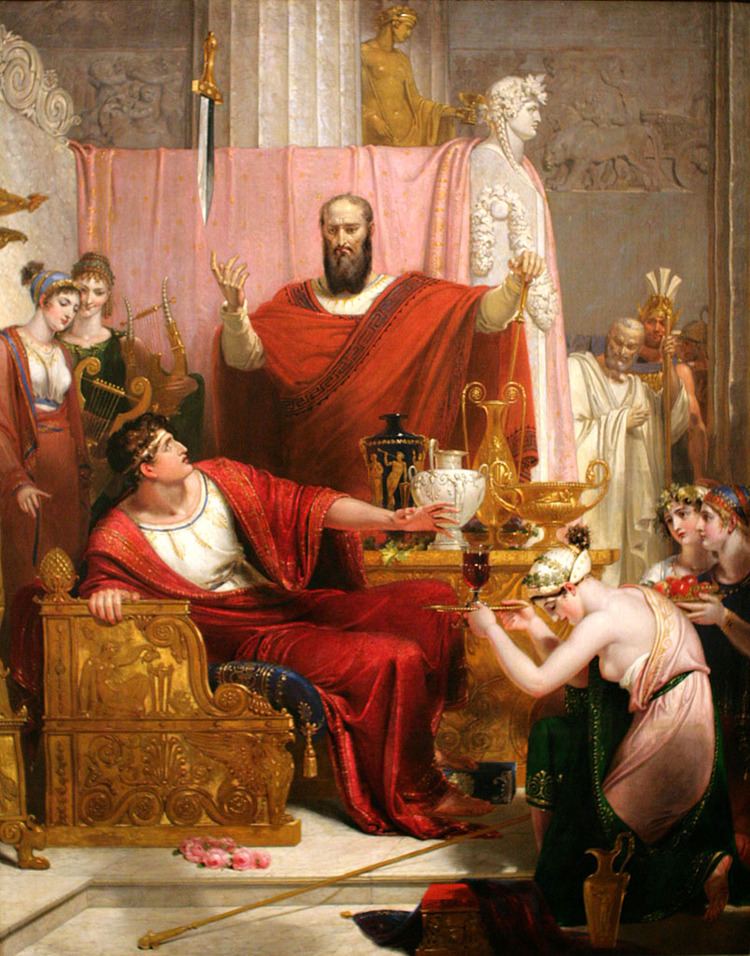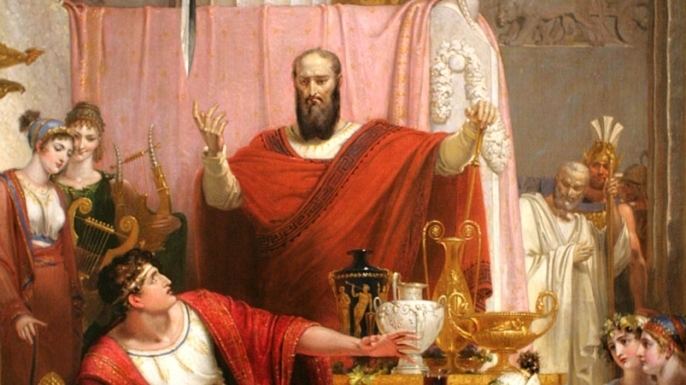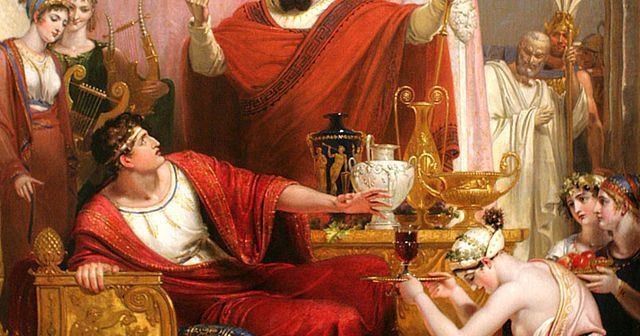Occupation Courtier | ||
 | ||
Ryse son of rome the legend of damocles
Damocles (/ˈdæməkliːz/; Greek: Δαμοκλῆς Dāmoklē̂s, literally: "fame of the people") is a figure featured in a single moral anecdote commonly referred to as "the Sword of Damocles", an allusion to the imminent and ever-present peril faced by those in positions of power. The Damocles of the anecdote was an obsequious courtier in the court of Dionysius II of Syracuse, a 4th-century BC tyrant of Syracuse, Sicily.
Contents
- Ryse son of rome the legend of damocles
- The sword of damocles
- Sword of Damocles
- Culture art and literature
- References

The anecdote apparently figured in the lost history of Sicily by Timaeus of Tauromenium (c. 356–260 BC). The Roman orator Cicero may have read it in Diodorus Siculus. He made use of it in his Tusculanae Disputationes, V. 21, by which means it passed into the European cultural mainstream.
The sword of damocles
Sword of Damocles

According to the story, Damocles was pandering to Dionysius, his king, and exclaimed to him that Dionysius was truly fortunate as a great man of power and authority, surrounded by magnificence. In response, Dionysius offered to switch places with Damocles so that Damocles could taste that very fortune firsthand. Damocles quickly and eagerly accepted the king's proposal. Damocles sat down in the king's throne surrounded by every luxury, but Dionysius arranged that a huge sword should hang above the throne, held at the pommel only by a single hair of a horse's tail. Damocles finally begged the king that he be allowed to depart because he no longer wanted to be so fortunate, realizing that with great fortune and power comes also great danger.

King Dionysius effectively conveyed the sense of constant fear in which a person with great power may live. Cicero used this story as the last in a series of contrasting examples for reaching the conclusion he had been moving towards in this fifth Disputation, in which the theme is that virtue is sufficient for living a happy life. Cicero asks, "Does not Dionysius seem to have made it sufficiently clear that there can be nothing happy for the person over whom some fear always looms?"
Culture, art, and literature
The sword of Damocles is frequently used in allusion to this tale, epitomizing the imminent and ever-present peril faced by those in positions of power. More generally, it is used to denote the sense of foreboding engendered by a precarious situation, especially one in which the onset of tragedy is restrained only by a delicate trigger or chance. Shakespeare's Henry IV expands on this theme: "Uneasy lies the head that wears a crown"; compare the Hellenistic and Roman imagery connected with the insecurity offered by Tyche and Fortuna.
In the Canterbury Tales, Chaucer refers to the sword of Damocles, which the knight describes to hang over Conquest. When the knight describes the three temples, he also pays special attention to the paintings, noticing one on the walls of the temple of Mars, "Above, where seated in his tower, /I saw Conquest depicted in his power/ There was a sharpened sword above his head / That hung there by the thinnest simple thread." (Lines 2026-2030)
The Roman 1st century BC poet Horace also alluded to the sword of Damocles in Ode 1 of the Third Book of Odes, in which he extolled the virtues of living a simple, rustic life, favouring such an existence over the myriad threats and anxieties that accompany holding a position of power. In this appeal to his friend and patron, the aristocratic Gaius Maecenas, Horace describes the Siculae dapes or "Sicilian feasts" as providing no savoury pleasure to the man, "above whose impious head hangs a drawn sword (destrictus ensis)".
The phrase has also come to be used in describing any situation infused with a sense of impending doom, especially when the peril is visible and close at hand—regardless of whether the victim is in a position of power. The American president John F. Kennedy compared the omnipresent threat of nuclear annihilation to a sword of Damocles hanging over the people of the world. Soviet First Secretary Nikita Khrushchev wanted the Tsar Bomba to "hang like the sword of Damocles over the imperialists' heads".
Woodcut images of the sword of Damocles as an emblem appear in sixteenth- and seventeenth-century European books of devices, with moralizing couplets or quatrains, with the import METUS EST PLENUS TYRANNIS (literally, "Fear is plentiful for tyrants", i.e., "A tyrant's fear is complete fear" — as it is the tyrant's place to sit daily under the sword). In Hollar, Wenceslaus (n.d.), Emblemata Nova, London , a small vignette shows Damocles under a canopy of state, at the festive table, with Dionysius seated nearby; the etching, with its clear political moral, was later used to illustrate Hobbes, Thomas (1651), Philosophicall Rudiments concerning Government and Society, London .
A much later representation of the phrase is seen in the Richard O'Brien's 1973 musical, The Rocky Horror Show, and its subsequent 1975 film counterpart, in the 6th song of the show, titled "The Sword of Damocles". In this song, the titular character, Rocky Horror, is created in a Frankenstein-esque fashion by the housemaster, Dr. Frank-N-Furter, and his first words & thoughts (presented in song form) upon creation were "The sword of Damocles is hanging over my head, and I've got the feeling someone's gonna be cutting the thread!" This is meant to act as a foreshadowing of the events following the show's second act, as Rocky seems to find himself in constant danger of torment at the hands of Riff Raff, the in-house handyman, who tortures him using a lit candle (the torture device varies, depending on the version of the show).
In The Dresden Files, young wizards that have broken one of the Seven Laws of Magic may be placed under the Doom of Damocles instead of executed if another, elder wizard stands up for them and takes over the young wizard's training, but if the young wizard breaks the Laws of Magic again, both they and their sponsor will be executed. Harry Dresden was placed under the Doom after killing his first mentor, Justin DeMorne, in self-defense, and pulled himself out from under it after Storm Front.
The sword of Damocles appears frequently in popular culture, including novels, feature films, television series, video games, and music.
